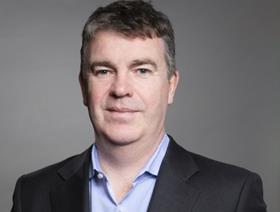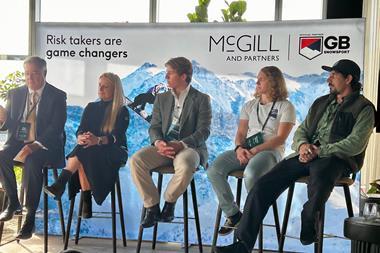The broker’s head of structured solutions admits that he lives ‘on tension and strain in the market’ in order to drive product innovation
For Brian Kirwan, head of structured solutions at broker McGill and Partners, the current hard market is “the biggest opportunity we have because it creates tension”, which – in turn – can lead to product innovation and problem solving.
Speaking exclusively to Insurance Times, Kirwan explains: “I live on tension and strain in the market, to try and develop products around it, so where there’s that strain, that gives me an opportunity.
“A soft market doesn’t help me because everything just goes through, whereas a hard market creates opportunities to solve problems.”
On the flip side however, challenges that Kirwan has seen arise from the hard market include “trying to get people [to] focus on doing something different when they’re just trying to get through their day-to-day world, when the underwriting community can make just as much money writing their traditional business in the traditional way in certain areas”.
Pushing boundaries
Kirwan joined McGill and Partners in 2019, with past experience in both reinsurance and underwriting under his belt. This led him to be the ideal fit to head up the broker’s structured solutions team, which combines reinsurance skills, securities, finance and captives to develop new products for corporate customers.

This includes a focus on creating multi-year, multi-line structures.
A key driver behind Kirwan’s work of late has been the hard market.
“You’re seeing large corporates either want to take increased retentions because premiums have accelerated or being forced to [take them] because they can’t get coverage,” he says.
“That’s putting pressure on captive balance sheets and encouraging people to think of new ways to really manage these larger retentions.
“In the soft market where everything could be placed, people didn’t really have to push the boundaries of thought in terms of structuring solutions. In a hard market, that’s where these solutions tend to grow.
“You’re seeing a lot of difficult to insure or uninsurable risks - people are going to start looking at captives and other solutions to try and manage [this] over time. Our role is to really understand the customer in that environment and build new structures and new ideas around captives and captive retentions.”
Parametric interest
One area that Kirwan has earmarked as “interesting” is parametric insurance, especially when linked to weather risks – he thinks this will gain more prominence this year.
He says: “We have a team looking at parametric trigger business, whether that’s our catastrophic weather or average weather.
“We also see trends in that space where the hardening market is probably making that more attractive from a pricing point of view; one of its advantages [is] around its immediate payout - CFOs and others will definitely see the advantage in a parametric structure.
“[Younger] generations may expect a much more slick, efficient payout environment and parametric can give that.”
Speaking on parametric insurance as an alternative for traditional business interruption (BI) cover, Kirwan adds: “As business models change, people are looking at triggers that will pay out automatically, so I think it could push more [parametric policies] because you’ll get a clear trigger and payout.
“But the way I would think about it is you’re better off insuring a small number of organisations against future pandemics so you don’t get the correlation, but you take the bet that there’s another one.
“It may be very difficult without government help to just give everybody cover for a pandemic.”
The growth of data use by the insurance sector and the debate around tangible versus intangible assets are further trends Kirwan is seeing across the market.
“The data environment and the amount of data - insurance has typically been a ‘once-a-year, send me the data’, whereas most companies are now multiple data per day, so that will definitely change structures,” he says.

“[There has also been] huge talk in the last few years about intangible versus tangible, particularly with the current trend in the pandemic and the fundamental change onto online.
“We’ve done the biggest change management project the world has ever seen and we’re now going to see that more and more business models are going to have different triggers or faster triggers other than fire damage that is going to damage their industries.
“Part of our discussions with clients will be around the different data that they’re collecting and how that drives your business and what risk you can take around it.”
Accelerating the future
Another area of opportunity that has been largely driven by the Covid-19 pandemic is the adoption of technology, adds Kirwan – this provides an opening for structured solutions to accommodate more new risks.
He explains: “Before, the future was always the digital future [with] working from home, flexible working and [the] change of business [models].
“But we basically accelerated the future in a day. We got business models immediately changing.
“The adoption of digital has been heavily driven by the pandemic. The move to online would not have happened for a number of years because of some inertia, but it’s just happened.
“In my world, it creates a huge opportunity because change like that generates different revenue models for companies, which generates different risks, which means that we need to help the market and the capacity providers adapt to those risks.”
Kirwan expands this thinking to offer the example of automated vehicles, highlighting how the risk following a crash has shifted from the individual driver to the corporate manufacturers producing the vehicles.
“The insurance business has to develop to understand how those risks are changing and mitigating what technology is doing to that to make sure we don’t become the ‘oyster card’,” he says.
This analogy is based on how oyster cards innovated the traditional paper ticketing system, yet in turn, these are now largely redundant as travellers either use their smartphones, smart watches or credit cards to pay for journeys.
“That’s the insurance industry’s biggest challenge – that we don’t solve today’s problems. We have to solve the future customer’s problems,” Kirwan notes.
CV
- July 2019, joined McGill and Partners as partner, head of structured solutions.
- October 2015, became the UK chief executive of Allianz Global Corporate and Strategy.
- In 2003, joined Allianz Risk Transfer, focusing on structured credit and insurance linked securities.
- Started career at reinsurance business Centre Re in 1992.
Hosted by comedian and actor Tom Allen, 34 Gold, 23 Silver and 22 Bronze awards were handed out across an amazing 34 categories recognising brilliance and innovation right across the breadth of UK general insurance.




















































No comments yet